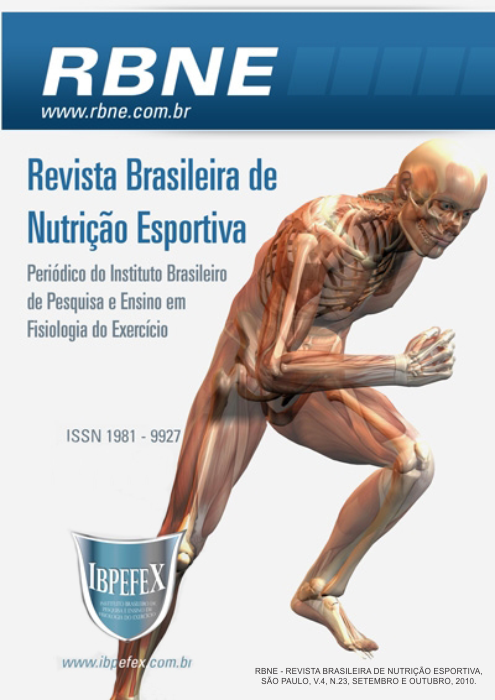Nutritional evaluation of aerobic gymnastic and artistic gymnastic athletes
Abstract
The gimnastic is quite popular among girls, who start early the career, pass the growth and development in intense physical activity. Objective: To evaluate and compare the body composition among Aerobic Gymnastics (GAME) and gymnastics (GA) athletes and observe their nutritional knowledge. 15 GAE and 15 GA athletes (9-15 years) had the BMI, height skinfold evaluated. The nutrition knowledge was assessed using a questionnaire on eating habits. There was difference between the groups in age and in all anthropometric measurements, except in z scores for height and BMI for age. Both modalities had higher prevalence below the 5th percentile in PCS. There was higher prevalence above the 15th percentile for GA group in the PCT and in group GAE, percentile between 5 and 15. There was no statistical difference between groups in measures PCS and PCT. It was observed a lower mean score on the nutrition in the GA group, but significant difference between the results. By standardizing the indices for age (BMI, stature, PCT and PCS), the difference between the gymnasts did not show significance. That indicates that the pattern of body composition, correcting for age, is the same in both groups. The gymnasts are considered normal weight, with a smaller pattern of fat accumulation than the population of non-athletes. There were no differences in body composition between the modalities when corrected for age. Both groups showed similar knowledge in nutrition.
References
- Benardot, D.; Czerwinski, C. Selected body composition and growth measures of junior elite gymnasts. Journal of the American Dietetic Association. Vol. 91. Num. 1. 1991. p. 29-33.
- Bernink, M.J.E.; Erich, W.B.M.; Peltenburg, A.L.; Zonderland, M.L.; Huisveld, I.A. Height, body composition, biological maturation and training in relation to socio-economic status in girl gymnasts, swimmers, and controls. Growth. Vol. 47. Num. 3. 1983. p. 1-12.
- Claessens, A.L.; Lefevre, J.; Beunen, G.; Malina, R.M. The contribution of anthropometric characteristics to performance scores in elite female gymnasts. Journal of Sports Medicine and Physical Fitness. Vol. 39. Num. 4. 1999. p. 355-360.
- Mcardle, W.D.; Katch, F.I.; Katch,V. L. Fisiologia do exercício-energia,nutrição e desempenho humano. 3. ed. Rio de Janeiro; Guanabara Koogan. p. 195-197/ 450-457, 1992.
- Ribeiro, B.G.; Soares, E.A. Avaliação do estado nutricional de atletas de ginástica olímpica do Rio de Janeiro e São Paulo. Revista de Nutrição. Vol. 15. Num. 2. 2002. p. 1–5.
- Ribeiro, B.G.; Soares, E.A. Avaliação do estado nutricional de atletas de ginástica olímpica do Rio de Janeiro e São Paulo. Rev. Nutr. Vol. 15. Num. 2. 2002. p. 181-191.
- Sinning, W.E.; Lindberg, G.D. Physical characteristics of college age women gymnasts. Research Quarterly. Vol. 43. Num. 2. 1972. p. 226-234.
- Slaughter, M.H.; Lohman, T.G.; Boileau, R.A.; Horswill, C.A.; Stillman, R.J.; Vanloan, M.D.; Bemben, D.A. Skinfold equations for estimation of body fatness in children and youth. Human Biology. Vol. 60. Num. 5: 1988. p. 709-723.
- Zetaruk, M.N. The young gymnast. Clinics in Sports Medicine. Vol. 19. Num. 4. 2000. p. 757-780.
Authors who publish in this journal agree to the following terms:
- Authors retain the copyright and grant the journal the right of first publication, with work simultaneously licensed under the Creative Commons Attribution License BY-NC which allows the sharing of the work with acknowledgment of the authorship of the work and initial publication in this journal.
- Authors are authorized to enter into additional contracts separately for non-exclusive distribution of the version of the work published in this journal (eg, publishing in institutional repository or book chapter), with acknowledgment of authorship and initial publication in this journal.
- Authors are allowed and encouraged to post and distribute their work online (eg, in institutional repositories or on their personal page) at any point before or during the editorial process, as this can bring about productive change as well as increase impact and impact. citation of published work (See The Effect of Free Access).






